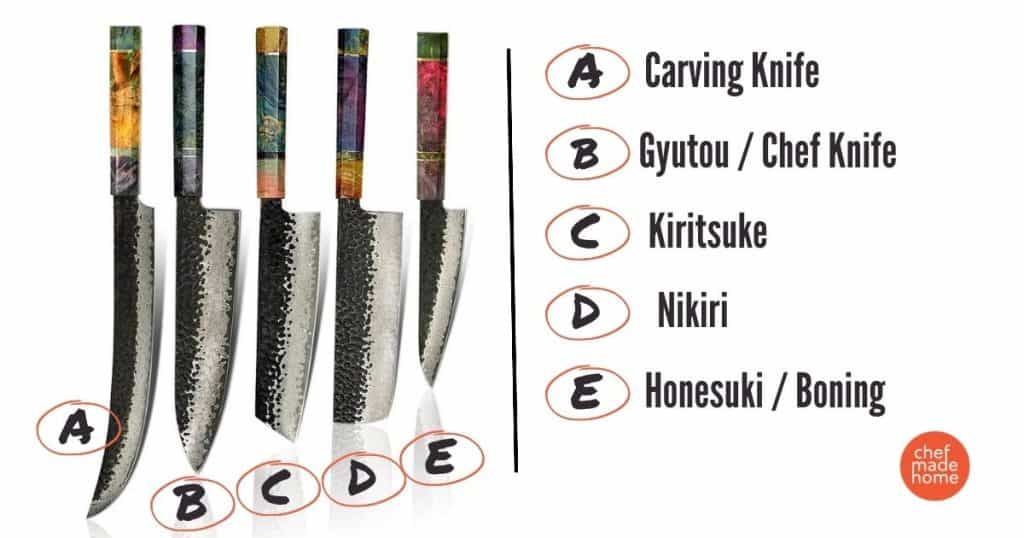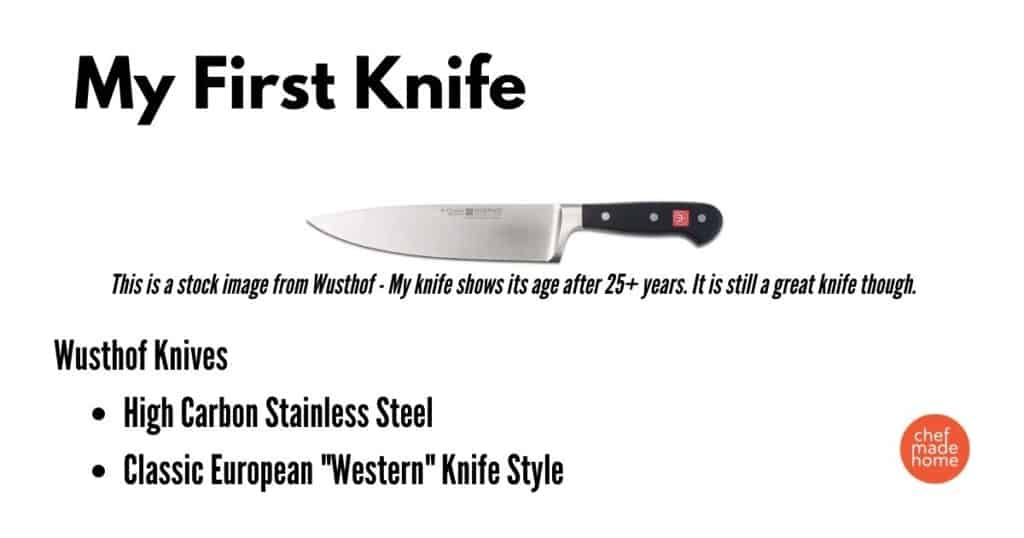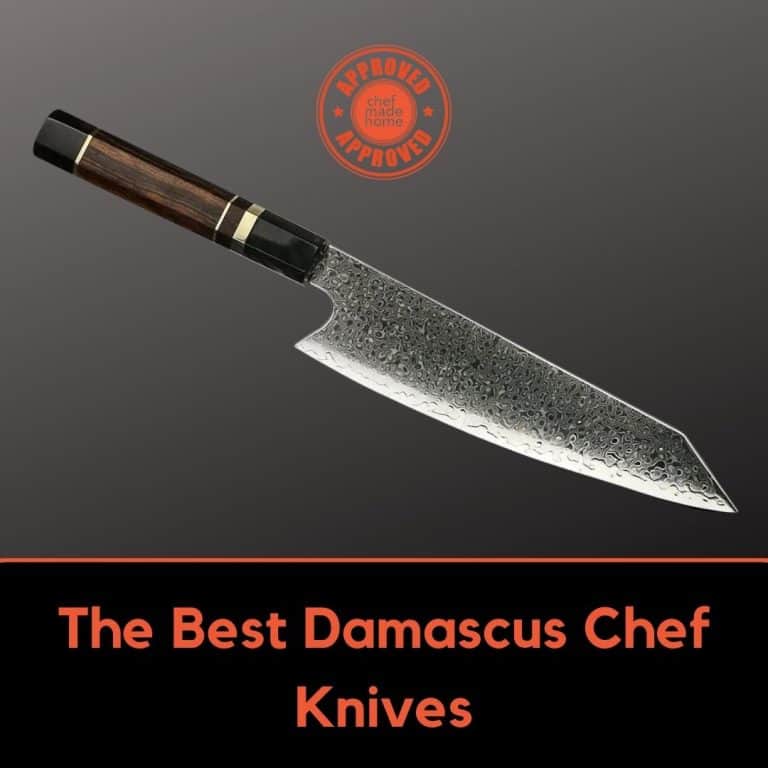If you’ve ever been in a professional kitchen, you know that the chefs there take their knives very seriously. So when I set out to find the best Damascus chef knives, I knew I had to go to the experts.
And that’s exactly what I did. I talked to my chef friends around the country and asked them to weigh in on which knives they use and why. It didn’t stop there but I won’t bore you with the deeper diving I did.
Here are the results of my quest to find the best Damascus chef knives out there.
Why Damascus chef knives are some of the best in the business
Damascus chef knives are a professional’s dream, and for good reason. Meticulously designed with alternating layers of steel and cladding, they boast supremely high-quality materials that produce an unbeatable razor-sharp edge capable of enduring professional level use.
Their Rockwell Hardness ensures long-lasting sharpness, while their construction provides the perfect combination of durability and lightness even professional chefs can appreciate. Whether you’re a professional chef or a passionate home cook, you can rest assure that Damascus chef knives will provide superior performance every time.
Finally, the performance of a Damascus chef knife is determined by its Rockwell Hardness. The Rockwell Hardness (often abbreviated as HRC) measures the resistance of metal to wear and tear and indicates how long a blade can stay sharp in use. A higher HRC rating means that a blade is harder and more durable, making it a great choice for professional chefs.
What makes a good Damascus chef knife
A good Damascus chef knife is the perfect tool for any top chef. It has all of the essential qualities to make it an exceptional piece of equipment for even the most demanding of cooking tasks. The damascus blade possesses an unmistakable damascus pattern, lending a unique and beautiful aesthetic to your kitchen knife set. But beauty isn’t enough — quality is key.
A well-crafted Damascus chef knife also provides exceptional performance in terms of sharpness, while providing an ergonomic handle that perfectly fits in the user’s hand and provides a comfortable grip during food preparation.
Lastly, a good balance between blade length and weight is essential for fine precision when slicing and dicing — making it the ideal sharp implement for any aspiring masterchef.
How to find the best Damascus chef knife for your kitchen
When it comes to selecting the best Damascus chef knife for your kitchen, you may want to consider a santoku knife or a chef’s knife for larger tasks such as cutting meat or fish, slicing and dicing vegetables and chopping herbs.
Utility knives will be helpful for prepping smaller ingredients and poultry. For peeling and trimming foods, a paring knife is an excellent tool to have in your collection. It’s important to do research on the type of knife that would be ideal for your needs and make sure it fits comfortably in your hand before making a purchase.
Taking into consideration the type of knife, its size, sharpness, weight and balance are all factors that will help ensure you select the perfect Damascus steel kitchen knife to add stylish sophistication to your culinary skills.

What is the Damascus Pattern?
When it comes to the beautiful Damascus pattern knives, the intricate look is created by forging multiple layers of steel together and folding them into each other.
This creates a unique pattern resembling ripples in water, hence the name “Damascus”. The process of creating this pattern takes skill and precision, making Damascus kitchen knives some of the best in the business.
The best Damascus steel knives on the market today
*These are not affiliate links or sponsored in any way. The damascus kitchen knives may not necessarily be the best either but it is what I buy and where I shop for my knives.
If you’re looking for the best Damascus chef knives on the market, you’re in luck! There are several amazing products available that will make sure your kitchen is always outfitted with the sharpest and most reliable blades around.
When I shop for my knives I go to JBPrince or when the budget allows, Chubo Knives. Chubo Knives are some of the most coveted knives in a chef’s knife roll. They are the premier seller for high quality Japanese style blue steel and Damascus knives.
JBPrince on the other hand is a retailer with more options. My two favorite brands are the Mcusta Zanmai, and Kikuichi.

Which one is right for you and your cooking needs
Choosing the perfect knife for home cooks, or professionals for that matter, is all about personal preference, as no single blade can do it all. From chopping to dicing, ease of use and comfort should be your first priority when selecting the right knife for your cooking needs.
Knowing exactly what tasks your new knife will be used for – and how often – are also key considerations when selecting the perfect knife for you and your home kitchen. With so many different shapes, sizes and styles available on the market today, it may seem daunting to pick just one.
But with a deliberate approach, home cooks can easily identify the right knife that fits comfortably in their hands, their style of cooking and their budget.
Types of Blades
When considering what type of knife to have in your kitchen, the options can be overwhelming. Santoku, Chef, Utility and Paring knives all have different functions and should each have a place in your kitchen arsenal. Santoku is a great all-purpose slicing knife that is multi-talented, while a chefs knife will allow you to chop more easily than Santoku’s with their wider blade body.
Then comes the utility knife that straddles the line between Santoku and chef’s knives. After these workhorses, you might also want to include a paring knife for fruits and vegetables that require a little more detailed cutting.
And if you’re regularly chopping through bones or carcasses a meat cleaver might be the tool for you. Lastly, boning knives are intended for separating meat from bones with ease and precision.
With so many types of blades available to make food preparation easier keep an eye on their condition as they will dull over time despite proper care – getting new knives just means more quality time spent in the kitchen!

Anatomy of a knife
Chef knives have become a staple kitchen tool in home and professional kitchens. To the casual eye, a chef knife is compact, maneuverable, and can handle most basic food prep tasks with ease.
But what’s underneath the hood? Let’s take an anatomy lesson of what makes up a chef knife to better understand why it is so crucial to any kitchen arsenal. Most chef knives consist of four parts: Handle, Tang, Bolster, and Blade. The Handle allows for comfortable gripping so that you can prepare with precision and accuracy without Slipping or fatigue.
Attached to the Handle via rivets or glue is the Tang which gives the Handle additional strength and stability when tackling hard-surfaced materials. The overall length of most chef knives ranges between 8-13 inches giving you enough blade length for precision cuts, along with Handle length for good balance and control.
Finally, choosing the right blade material is key as it determines Strength and durability, but also how well you will be able to sharpen and maintain your knife over time. Whether you’re investing in a top-shelf santoku or just picking up an inexpensive all-purpose utility knife – having an understanding of the anatomy of a chef knife will help pick one that suits your level of experience in the kitchen best!
What is Damascus Steel?
Have you ever heard of Damascus steel? It’s high carbon steel, with a high carbon content, typically in the range of 1.5-2%, making it harder than traditional stainless steel. First created during the Iron Age, Damascus steel would be tempered and quenched by artisans in India and the Middle East to give it its well known strength and distinctive patterning.
In recent years, Japanese sword makers have been praised for their excellent recreations of this unique high carbon steel — creating modern interpretations of ancient layered craftsmanship.
Damascus steel can now be found in everything from kitchen knives to jewelry, showcasing layers and laminates of high carbon content metals crafted together with beauty and precision unmatched by more modern stainless steels.
What is VG-10 Steel?
VG-10 steel is a Japanese stainless steel alloy with a reputation for being of the highest quality in the world. This unique alloy is crafted from carbon, cobalt, molybdenum, vanadium and chromium; each of these elements combine together to create an exceedingly strong and corrosion-resistant metal that works perfectly for crafting kitchen knives due to its ability to maintain an incredibly sharp edge retention.
VG-10 steel is commonly found in Japanese culinary knives that also possess a beautiful aesthetic due to the composition of this remarkable metal.

Damascus Steel Knives Vs Stainless Steel Knives
A good knife can be the difference between a good cooking experience and a great one. It’s important to choose the right type of knife that fits your needs — after all, not all knives are created equal!
For those looking for a good, reliable blade, stainless steel or Damascus steel may be good choices. Stainless steel is better for corrosion resistance and maintenance but lacks sharpness compared to Damascus steel, which takes longer to sharpen and develop patina due to its unique patterns of various steels folded together.
Both types make good knives in their own way, making it an interesting decision whether you want a long-lasting stainless steel or the unique look of Damascus steel.
A final word on choosing a Damascus chef knife
When it comes to choosing the best knife for your kitchen, a Damascus chef knife is a great option. Not only do they boast an aesthetically pleasing damascus steel blade, but they also have excellent edge retention, ensuring that you can keep your new knife nice and sharp.
Japanese knives tend to be some of the best in the business – durable, stylish, and made with top-notch materials – making them an optimal choice for any culinary enthusiast. All in all, when it comes to opting for the best kitchen companion on the market, look no further than a quality Damascus steel blade from one of Japan’s finest best japanese knifemakers.
When it comes to finding the best Damascus chef knife for your kitchen, remember that quality should reign supreme. Not only do these kinds of knives boast a classic and attractive look, but they offer agility and strength when tackling almost any task in the kitchen.
The three Damascus chef knives outlined in this post all have their own distinct features and utilizes, so the choice is ultimately up to you and your cooking needs. With that in mind, take time to consider each of these knives, their benefits and what you’ll gain from investing in one.
If you heed this advice, there’s no doubt you’ll end up with a reliable Damascus chef knife―one that can stand the test of time both aesthetically as well as functionally! Above all else, be sure to enjoy cooking like never before with your new Damascus blade by your side.

